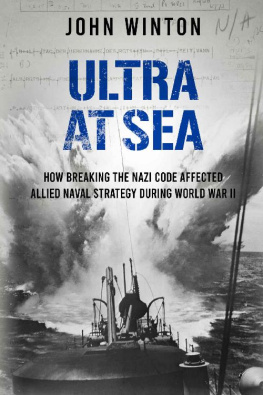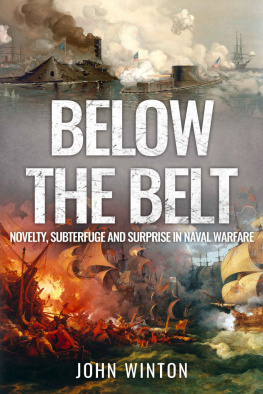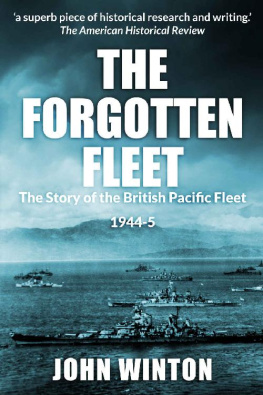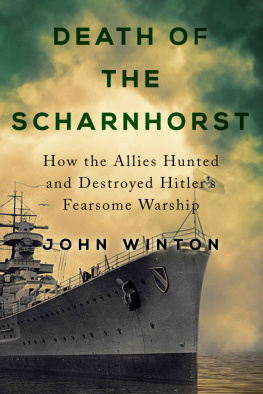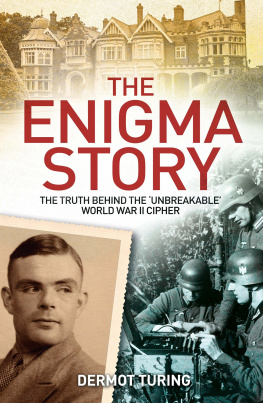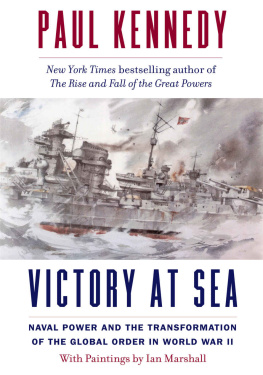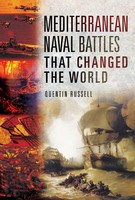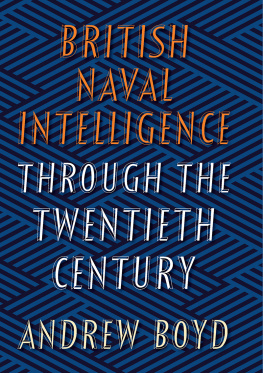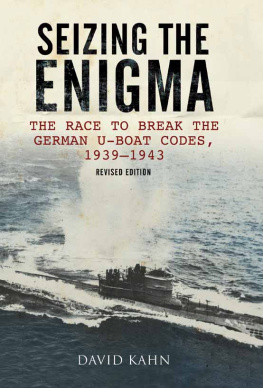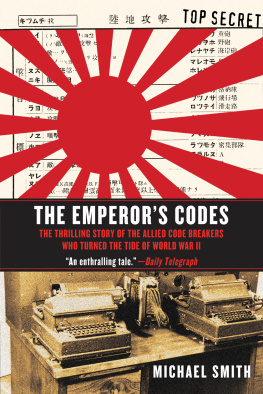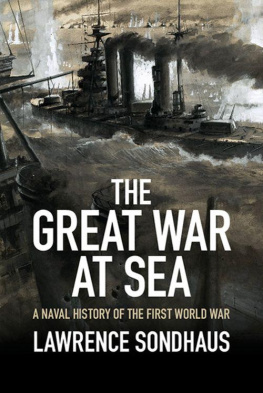ULTRA AT SEA
John Winton

TABLE OF CONTENTS
1: EARLY PRE-ULTRA DAYS
When one player consistently knows which cards his opponent holds, how much and how often dare he go on winning before his opponent begins to suspect and changes the cards or the game? That, in essence, was the main problem unique in the history of warfare which the possession of Special Intelligence (later to be code-named ULTRA) posed for the Allies in World War Two.
The problem was especially acute at sea, where the Admiralty traditionally exercised only remote control, redistributing naval forces around the various commands worldwide to meet the changing needs of strategy and giving the local Commander-in-Chief all the forces and intelligence it could, but then wherever possible leaving him, as the man on the spot, to make the final decisions. Bitter experience had shown that interference from afar often led to catastrophe.
But ULTRA eventually gave the Admiralty an unprecedented overall view of the enemys naval operations and intentions and, because only the Admiralty could know the whole picture, ULTRA forced the Admiralty to take a much closer and more active part in the day-to-day running of operations, especially in the early days and particularly in the Atlantic and Home commands.
Always a present operational gain had to be balanced against the future prospect of losing what Mr Churchill called the precious secret of ULTRA. Too much success could be disastrous. Too many U-boats sunk, for instance, at their remote refuelling rendezvous might arouse the enemys suspicions and cause him to change cyphers which had been only broken after much labour over a long period of time. Worse, it might even cause him to doubt the inviolability of the Enigma coding machine.
Therefore, in the early days, much of the intelligence provided by ULTRA could not be used, either at once or for some considerable time. Nobody knew how much could be used operationally. The Admiralty had to gain experience gradually. But as time passed and a wider intelligence picture was revealed, as more and more jigsaw pieces slotted into place, as the significance of events and signals sometimes years in the past became apparent, so ULTRA could be used with growing confidence and in an ever wider operational capacity.
However, just as at first the operational use of ULTRA erred intentionally on the side of over-timidity, so, in the latter days of the war, as one intelligence officer later admitted, if there had been a turning-off of the tap of Special Intelligence, before the end of the war, and before the result was beyond any reasonable doubt, the intelligence directorates would have been hard put to it to find those capable, by a keen analytical examination of the lesser grades of intelligence, of producing an accurate forecast or estimate of the enemys dispositions and intentions.
So accustomed did intelligence officers eventually become to a steady and complete flow of ULTRA that other forms of intelligence, which might tend to point in another direction, were sometimes ignored. For example, the German advance in the Ardennes in December, 1944, was not foreshadowed by ULTRA because the Germans were keeping W/T silence. But excellent intelligence from photo-reconnaissance, which had revealed a considerable build-up of German forces and vehicles in the rear of the Ardennes front, was discounted.
ULTRA, though crucial, was after all only one form of intelligence. Under the general heading of Sigint, or Signal Intelligence, which was any Intelligence derived from the Signal Intelligence Service, were the Y Service, as it was known in Great Britain, or Radio Intelligence Service as it was known in the United States, which was responsible for the interception and exploitation of all enemy radio transmissions which might yield intelligence, including direction finding (D/F), navigational beacons and aids, and enemy radar and infra-red transmissions. T.A., or Traffic Analysis, was the study of communications networks and the procedures, signals, callsigns, and plain language messages passing over them, coupled with the use of D/F and other technical aids. RFP was a process which filmed the type and peculiarities of a particular transmitter, while TINA was the study of the idiosyncratic morse characteristics of individual wireless operators.
Various forms of intelligence had code-words. ULTRA was the code-word for Special Intelligence, resulting from the solution of high-grade codes and cyphers. Crypt Intelligence, code-worded CIRO-PEARL, was intelligence resulting from medium grade codes and cyphers, or, code-worded PEARL, from low-grade codes and cyphers. Intelligence from Traffic Analysis, excluding D/F, was THUMB 1, while THUMB 2 was that derived from a study of D/F bearings and results from other technical aids.
But even Sigint itself was only one of the intelligence sources available. There were reports from warships visiting foreign ports, and from naval attachs accredited to foreign embassies. Returning businessmen could often provide invaluable information from their business contacts and personal observations. Photo-reconnaissance, even by the beginning of the war, was a highly developed skill. There were reports from agents or foreign nationals, interrogation of prisoners of war, those of the enemy after capture and our own after escape. A study of enemy newspapers and enemy radio was always rewarding; in the autumn of 1940 the exultant German media, rejoicing in success, provided priceless intelligence on, for example, the U-boats, the individual captains, and their crews (so much intelligence, in fact, that for the rest of the war Naval Intelligence Department resisted the strongest pressures, from the Prime Minister downwards, to provide more publicity material on the successes of Allied submarines and Allied anti-U-boat measures).
Much geographical, topographical and statistical intelligence could be gained from pre-war publications. A holiday resort brochure, or a family snapshot, could well show the width, gradient and even the texture of a possible assault landing beach. The 1938 edition of Janes Fighting Ships contained a full-page advertisement for German Schnellbootes ; thus, the Admiralty was actually urged to buy new, before the war, one of the E-boats it made such strenuous efforts to capture after the war had begun.
But ULTRA was the most highly prized intelligence jewel of all. In January, 1940, when the Admiralty became aware of the potentialities of this Special Intelligence, which was from a particularly sensitive and absolutely reliable source, it warned the C-in-C Home Fleet and certain other chosen senior naval officers that it was possible they might be receiving intelligence from high-grade Sigint which would be sent to them in the Flag Officers cypher, in special messages prefixed by the code-word HYDRO. The prefix HYDRO was used until June, 1941, when the German naval Enigma was first read currently and the barest trickle of Special Intelligence suddenly became a flood. HYDRO was then replaced by ULTRA.
The Admiralty took the strictest precautions to safeguard the ULTRA secret. It was revealed only to certain Flag and Senior Officers, and not more than three other selected members of the cypher staff. The names of these ULTRA-indoctrinated officers had to be communicated to NID. NID had to be informed of any alterations to the list. When a name was to be added, it had to be reported to NID at least a month beforehand and the new officer had to be briefed by the Flag or Senior Officer concerned. An ULTRA-briefed officer was not supposed to place himself in any position where he could be captured by the enemy. (This posed particular problems for the RAF, when indoctrinated officers had to be restrained from returning to flying with an operational squadron.)
Next page
